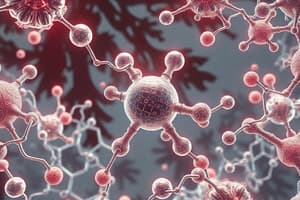Podcast
Questions and Answers
Why do droplets of water form beads rather than spread out on a leaf?
Why do droplets of water form beads rather than spread out on a leaf?
Due to the cohesive nature of water molecules, which creates surface tension.
What makes it possible for a needle to float on water?
What makes it possible for a needle to float on water?
The surface tension of water allows the needle to float despite its density being greater than water.
What are intermolecular forces of attraction?
What are intermolecular forces of attraction?
Forces that act between molecules and affect physical properties.
How do intermolecular attractive forces affect physical properties?
How do intermolecular attractive forces affect physical properties?
What is viscosity?
What is viscosity?
What is capillarity?
What is capillarity?
What does surface tension allow liquids to do?
What does surface tension allow liquids to do?
Match the following types of intermolecular forces with their examples:
Match the following types of intermolecular forces with their examples:
The boiling point of NaCl is _____ °C.
The boiling point of NaCl is _____ °C.
The boiling point of ICl is _____ °C.
The boiling point of ICl is _____ °C.
The boiling point of Br2 is _____ °C.
The boiling point of Br2 is _____ °C.
Study Notes
Intermolecular Forces Overview
- Intermolecular forces are attractions between molecules that play a critical role in determining physical properties.
- These forces affect characteristics such as melting point, boiling point, viscosity, surface tension, capillarity, and solubility.
Types of Intermolecular Forces
- Ionic Bonds: Strongest, e.g., Sodium Chloride (NaCl) with a boiling point of 1413°C.
- Polar Molecular Bonds: Moderate strength, e.g., Iodine Monochloride (ICl) with a boiling point of 97°C.
- Nonpolar Molecular Bonds: Weaker, e.g., Bromine (Br2) with a boiling point of 59°C.
Physical Properties Affected
- Boiling Point: Affected by the strength of intermolecular forces; higher forces lead to higher boiling points.
- Surface Tension: The tendency of liquid surfaces to resist external forces due to cohesive molecular interactions.
Viscosity
- Defined as the resistance of a liquid to flow; stronger intermolecular forces correlate to higher viscosities.
Capillarity
- The ability of liquid to move in narrow spaces against gravity due to adhesive forces being stronger than cohesive forces.
Biological Macromolecules
- Structure-Function Relationship: The unique structures of carbohydrates, lipids, nucleic acids, and proteins determine their respective properties and functions in biological systems.
Practical Observations
- Water droplets bead on surfaces due to surface tension.
- Insects like water striders can float on water because of the high surface tension created by cohesive forces among water molecules.
Studying That Suits You
Use AI to generate personalized quizzes and flashcards to suit your learning preferences.
Related Documents
Description
This quiz covers the key concepts of intermolecular forces and their implications on biological macromolecules. Students will describe types of intermolecular forces and explain their impact on substance properties. It also explores how the structures of carbohydrates, lipids, nucleic acids, and proteins relate to their functions.




